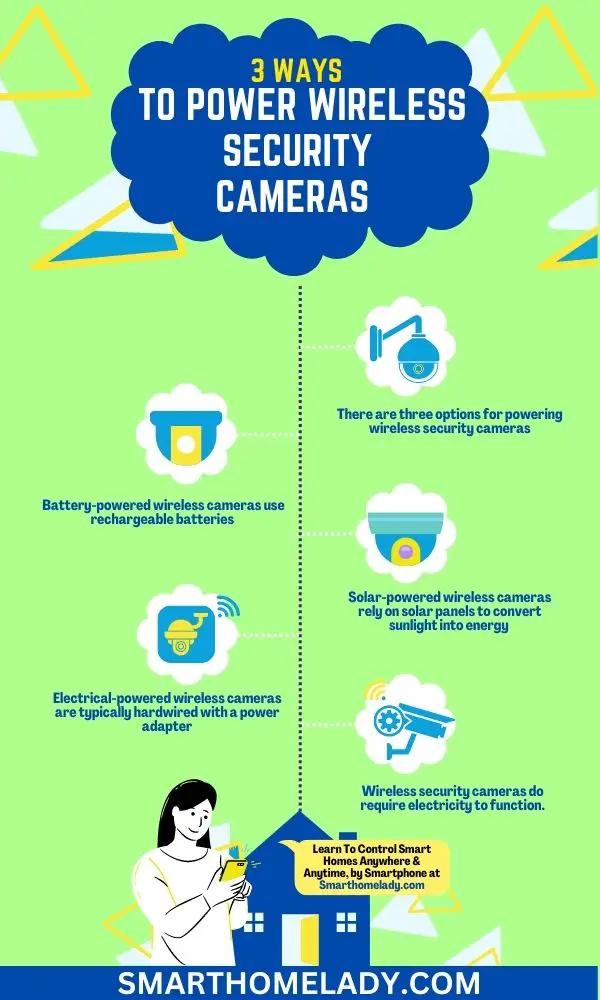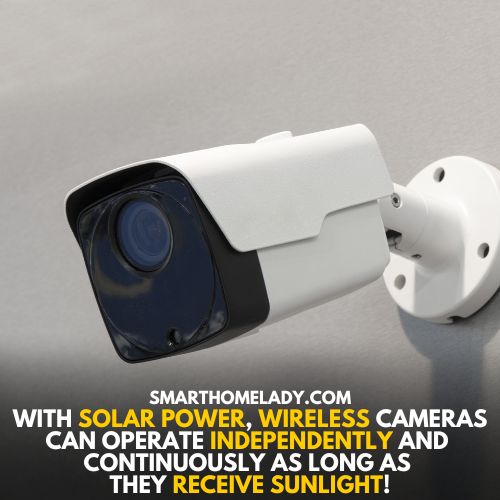As a homeowner or business owner, ensuring the safety and security of your property is of utmost importance. One powerful tool that can help in this endeavor is wireless security cameras.
These cameras offer convenience and flexibility, allowing you to monitor your property remotely without the need for complicated wiring.
But have you ever wondered; how do wireless security cameras get power? In this article, I will explore 3 different options for powering wireless security cameras.

Contents
- 1 How are wireless security systems powered? 3 Options To Power
- 2 Do wireless security cameras need electricity?
- 3 How do I run power to my wireless security camera?
- 4 Do security cameras work if the Wi-Fi is off?
- 5 What is the best way to power a wireless security camera?
- 6 Do Security Cameras Work Without Power?
- 7 Conclusion
How are wireless security systems powered? 3 Options To Power
There are three options for powering wireless security cameras: battery-powered, solar-powered, and electrical-powered,
- Battery-powered wireless cameras use rechargeable batteries to provide the necessary power without the need for a constant electrical source.
- Solar-powered wireless cameras rely on solar panels to convert sunlight into energy, making them a more environmentally friendly option that can operate even in remote locations.
- Electrical-powered wireless cameras are typically hardwired with a power adapter, allowing them to draw electricity from an outlet.
1. Battery Powered Wireless Cameras
The first option wireless security cameras get power is through battery power. Many wireless security cameras are equipped with rechargeable batteries that provide them with the necessary power to operate.
These batteries can typically last anywhere from a few weeks to several months, depending on factors such as camera usage and environmental conditions.
Battery-powered cameras are an excellent choice if you want a truly wire-free solution and don’t have access to electrical outlets near the camera installation location.
Battery-powered wireless cameras offer a convenient and hassle-free solution for keeping an eye on your property without the need for complicated wiring or constant power source management.
Factors To Consider When Choosing Battery-Powered Wireless Cameras
- One important factor to consider when choosing battery-powered cameras is the longevity of the batteries. Rechargeable batteries are recommended as they can be reused, saving you money in the long run.
- However, it’s essential to choose high-quality rechargeable batteries to ensure optimal performance and longevity.
- When choosing a battery-powered wireless camera, it’s crucial to consider factors such as video quality, field of view, storage options (cloud-based or local), and compatibility with other smart home devices if desired.

Maximizing Battery Life Of Wireless Camera
To maximize the battery life of your wireless camera, there are a few best practices you can follow.
- First, adjust the camera settings to minimize unnecessary recording or streaming, such as reducing motion detection sensitivity or setting specific recording schedules.
- Additionally, placing the camera in an area with good Wi-Fi signal strength will prevent excessive battery drain from constant reconnection attempts.
- Lastly, regularly checking and cleaning the camera’s lenses and ensuring firmware updates are installed can help optimize its efficiency.
By selecting a camera that meets your specific needs and following these best practices for maximizing battery life, you can enjoy reliable surveillance without worrying about frequent battery replacements.
Must Read: Do Wireless Security Cameras Need Batteries?
2. Solar Powered Wireless Cameras
The second option for powering wireless security cameras is solar power. Solar-powered cameras harness energy from the sun using built-in solar panels.
This renewable energy source eliminates the need for external power sources or batteries, making it an eco-friendly and cost-effective option in the long run.
Solar-powered cameras work well in areas with sufficient sunlight exposure throughout the day, ensuring continuous operation even during extended periods of cloudiness or darkness.

Solar-powered cameras offer a convenient and eco-friendly solution for keeping an eye on your property without the hassle of complicated wiring or constantly managing power sources.
With solar power, these cameras can operate independently and continuously as long as they receive sunlight.
Advantages Of Solar-Powered Wireless Security Cameras
The advantages of using solar-powered wireless cameras include:
- Cost-effectiveness – Solar-powered cameras eliminate the need for expensive electrical installations, saving you money on installation costs.
- Easy installation process – These cameras can be easily installed in any location that receives sufficient sunlight, without the need for drilling holes or running wires.
- Maintenance requirements – Since solar-powered cameras don’t rely on traditional power sources, they require minimal maintenance once installed.
Disadvantages Of Solar-Powered Wireless Security Cameras
There are also some disadvantages to consider when opting for solar-powered wireless cameras.
- The main drawback is their reliance on sunlight. In areas with limited sun exposure or during cloudy days, the camera’s performance may be affected.
- Additionally, initial costs may be higher compared to battery-powered options due to the inclusion of solar panels and associated equipment.
So, solar-powered wireless cameras offer a cost-effective and environmentally friendly solution for surveillance needs while considering their specific advantages and limitations.
Must Read: Do Wireless Security Cameras Need Internet?
3. Electrical Powered Wireless Cameras That Needs To Be Plugged
When we say something is wireless, it means that the information it’s sending doesn’t require any pesky cables to travel from the camera to the receiver. Pretty cool, right?
However, don’t be fooled – wireless security cameras still need an electrical power source. You’ll have to connect them to an electrical outlet using a good old cable to keep them up and running.
It is something to keep in mind, especially if you plan on installing a wireless or Wi-Fi security camera outdoors.
During the installation process, the camera is connected to the power source through the use of electrical wiring and a power adapter, which converts the electrical current to match the camera’s requirements.
You’ll need to consider the distance between the camera and its power supply. After all, we don’t want our cameras to run out of juice in the middle of an important surveillance operation.
It is important to ensure that the wiring is properly installed and meets safety standards to prevent any potential hazards or malfunctions.
Once installed, these cameras provide a reliable and continuous power supply without the need for battery replacements or recharging.
However, it is essential to regularly check and maintain the electrical connections and adapters to ensure proper functionality and avoid any potential issues.
Suggested Reading: How To Connect Wireless Cameras To Phone?
Frequently Asked Questions FAQs
Do wireless security cameras need electricity?
Yes, wireless security cameras do require electricity to function. While they may not need a direct connection to power outlets like traditional wired cameras, they still need a power source to operate.
Most wireless security cameras are powered by batteries or have a power adapter that needs to be plugged into an electrical outlet.
It is important to ensure that the camera’s power source is reliable and consistent to ensure proper functioning.
How do I run power to my wireless security camera?
To power a wireless security camera, you have a few options. If your camera is battery-powered, simply make sure the batteries are charged or replace them when needed.
Alternatively, some cameras come with a power adapter that can be plugged into a nearby electrical outlet.
In cases where you want to install the camera in a remote location without access to an outlet, you can consider using a solar panel or a battery pack specifically designed for security cameras.
These options provide a continuous source of power, ensuring your camera remains operational.
Do security cameras work if the Wi-Fi is off?
No, security cameras that rely on Wi-Fi connectivity will not work if the Wi-Fi is turned off. These cameras need a stable internet connection to transmit data and footage to your smartphone, computer, or a cloud storage system.
When the Wi-Fi is off, the camera cannot send the video feed or receive remote commands.
However, it is worth noting that some wireless security cameras offer local storage options, such as an SD card, which can continue recording even without an active Wi-Fi connection.
In such cases, you can access the recorded footage later when the Wi-Fi is restored.
What is the best way to power a wireless security camera?
The best way to power a wireless security camera depends on your specific needs and circumstances.
If you have access to an electrical outlet nearby, using a power adapter is a convenient option. It ensures a continuous power supply and eliminates the need to replace batteries.
However, if you want to install the camera in a remote location or prefer a more eco-friendly approach, you can opt for solar-powered cameras. These cameras use solar panels to convert sunlight into electricity, providing a reliable and sustainable power source.
Additionally, battery-powered cameras are a flexible solution as they can be installed anywhere without the need for external power sources.
Do Security Cameras Work Without Power?
No, security cameras do not work without power. Without a power source, whether it’s batteries, an electrical outlet, or alternative power options like solar panels, the camera will not function.
Power is necessary to operate the camera’s internal components, including the lens, image sensor, and data transmission system.
It is crucial to ensure a consistent power supply for your security camera to ensure uninterrupted surveillance and reliable performance.
Conclusion
In conclusion, wireless security cameras are powered using three different options: battery power, solar power, and AC power. Each option has its own advantages and disadvantages, depending on the specific needs of the user.
Ultimately, choosing the right power source for your wireless security camera depends on factors such as location, accessibility to electricity, maintenance requirements, and personal preference.
Understanding these options will help you make an informed decision when selecting a wireless security system that best suits your needs while ensuring reliable monitoring capabilities for your property.
Sources
- Naderiparizi, S., Parks, A. N., Kapetanovic, Z., Ransford, B., & Smith, J. R. (2015, April). WISPCam: A battery-free RFID camera. In 2015 IEEE International Conference on RFID (RFID) (pp. 166-173). IEEE. (Source Link)
- Abas, K., Obraczka, K., & Miller, L. (2018). Solar-powered, wireless smart camera network: An IoT solution for outdoor video monitoring. Computer Communications, 118, 217-233. (Source Link)
- Sruthy, S., & George, S. N. (2017, August). WiFi-enabled home security surveillance system using Raspberry Pi and IoT module. In 2017 IEEE International Conference on Signal Processing, Informatics, Communication and Energy Systems (SPICES) (pp. 1-6). IEEE. (Source Link)


